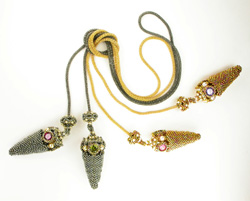|
An Italian
scientist in 1582, named Galileo, discovered that time could
be told by using a pendulum. In the mid 1600’s a Dutchman
named Christian Huygens developed a way of using a weight
driven pendulum as the driving device for a clock. It wasn’t
long before Long Case clocks (also known as Grandfather
clocks or Tall---Case Clocks) were being produced in
England.
The pendulum
was being used to attempt to keep accurate time. It wasn’t
until the anchor escapement had been developed, that when
used in conjunction with a pendulum, accuracy was achieved.
The most famous clock maker, Thomas Tompion, produced the
most beautiful watches and Long Case clocks, of which quite
a few are still in existence today.
Shapes,
reminiscent of antique clock pendulums, swing at the ends of
a luxurious metal knit chain. Beaded bezel CZs become part
of two 3--‐dimensional pendulum shapes using a combination
of stitches. The openwork portion of each shape draws the
viewer’s eye to see if pendulums are indeed hollow. The
beaded beads use the same enticing approach showing a bit of
color inside each bead, while discreetly making the
attachment to the metal knit chain. |

